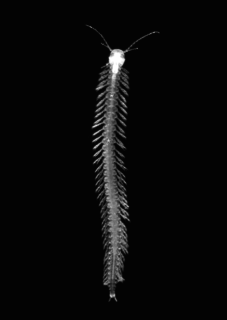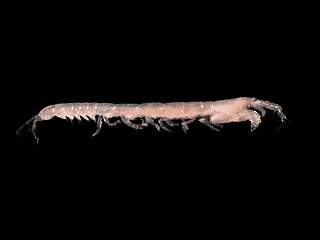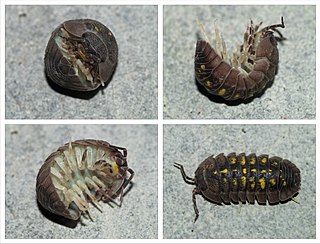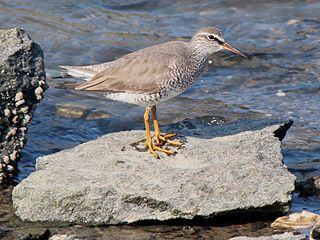
The black-winged stilt is a widely distributed very long-legged wader in the avocet and stilt family (Recurvirostridae). The scientific name H. himantopus was formerly applied to a single, almost cosmopolitan species. It is now normally applied to the form that is widespread in Eurosiberia and Africa and which was formerly regarded as the nominate subspecies of Himantopus himantopussensu lato. The scientific name Himantopus comes from the Greek meaning "strap foot" or "thong foot". Most sources today accept 2–4 species. It is sometimes called pied stilt, but that name is now reserved for the Australian species, Himantopus leucocephalus.

The common sandpiper is a small Palearctic wader. This bird and its American sister species, the spotted sandpiper, make up the genus Actitis. They are parapatric and replace each other geographically; stray birds of either species may settle down with breeders of the other and hybridize. Hybridization has also been reported between the common sandpiper and the green sandpiper, a basal species of the closely related shank genus Tringa.

The greater sand plover is a small wader in the plover family of birds. The spelling is commonly given as "greater sandplover" or "greater sand-plover", but the official British Ornithologists' Union spelling is "Greater Sand Plover". The genus name Charadrius is a Late Latin word for a yellowish bird mentioned in the fourth-century Vulgate. It derives from Ancient Greek kharadrios a bird found in ravines and river valleys. The specific leschenaultii commemorates the French botanist Jean Baptiste Leschenault de la Tour.

The long-toed stint, Calidris subminuta, is a small wader. The genus name is from Ancient Greek kalidris or skalidris, a term used by Aristotle for some grey-coloured waterside birds. The specific subminuta is from Latin sub, "near to" and minuta, "small" from its similarity to the little stint, Calidris minuta.

Remipedia is a class of blind crustaceans found in coastal aquifers which contain saline groundwater, with populations identified in almost every ocean basin so far explored, including in Australia, the Caribbean Sea, and the Atlantic Ocean. The first described remipede was the fossil Tesnusocaris goldichi. Since 1979, at least seventeen living species have been identified in subtropical regions around the world.
U.S. states, districts, and territories have representative symbols that are recognized by their state legislatures, territorial legislatures, or tradition. Some, such as flags, seals, and birds have been created or chosen by all U.S. polities, while others, such as state crustaceans, state mushrooms, and state toys have been chosen by only a few.

The crustacean order Tanaidacea make up a minor group within the class Malacostraca. There are about 940 species in this order.

Armadillidiidae is a family of woodlice, a terrestrial crustacean group in the order Isopoda. Unlike members of other woodlice families, members of this family can roll into a ball, an ability they share with the outwardly similar but unrelated pill millipedes and other animals. This ability gives woodlice in this family their common names of pill bugs or roly polies. Other common names include slaters and doodle bugs. The best known species in the family is Armadillidium vulgare, the common pill bug. Pill bugs are native to Europe, wherefrom they were introduced to the Americas.
The Larsen Islands are a small group of islands north-west of Moreton Point, the western extremity of Coronation Island, in the South Orkney Islands of Antarctica. They were discovered by Captains George Powell and Nathaniel Palmer on the occasion of their joint cruise in December 1821. The islands were named on Petter Sørlle's chart, based upon his survey of the South Orkney Islands in 1912–1913, in honour of Carl Anton Larsen.

Princess Ragnhild Coast is the portion of the coast of Queen Maud Land in Antarctica lying between 20° E and the Riiser-Larsen Peninsula, at 34° E. All but the eastern end of the coast is fringed by ice shelves. It was discovered by Capt. Hjalmar Riiser-Larsen and Capt. Nils Larsen in aerial flights from the ship Norvegia on February 16, 1931, and named for Princess Ragnhild of Norway. Vestvika Bay is a large bay on the west side of Riiser-Larsen Peninsula; it was mapped from air photos taken by the Lars Christensen Expedition, 1936–37, and named Vestvika, meaning "west bay."

Riiser-Larsen Ice Shelf is an ice shelf about 250 miles (400 km) long on the coast of Queen Maud Land, Antarctica, extending from Cape Norvegia in the north to Lyddan Island and Stancomb-Wills Glacier in the south.

The masked duck is a tiny stiff-tailed duck ranging through the tropical Americas. They are found from Mexico to South America and also in the Caribbean. Primarily not migratory, masked ducks are reported as very uncommon vagrants in the southernmost United States, along the Mexican border and in Florida. As of 2000, the conservation status for masked ducks in Texas is 3,800 birds. On April 1, 1962, it was recorded from Lowndes County, Georgia, where it was photographed by Alexander Wetmore.

The tattlers are the two very similar bird species in the shorebird genus Tringa. They formerly had their own genus, Heteroscelus. The old genus name means "different leg" in Greek, referring to the leg scales that differentiate the tattlers from their close relatives, the shanks.

Nordre Isfjorden National Park lies on Spitsbergen Island in the Svalbard archipelago, Norway. It lies across the Isfjorden north of Barentsburg. The park was opened in 2003.

Salim Ali Bird Sanctuary is an estuarine mangrove habitat, which is declared as the bird sanctuary, and located on western tip of the Island of Chorão along the Mandovi River, Goa, in India. The sanctuary is named after Salim Ali, the eminent Indian ornithologist.

The Riiser-Larsen Peninsula is a large peninsula forming the western portal to Lützow-Holm Bay and marking the separation of the Princess Ragnhild and Prince Harald Coasts. It was named after Captain Hjalmar Riiser-Larsen who discovered the peninsula in a flight from the Norvegia on 21 February 21 1931.

Moreton Point is a point 1 nautical mile (2 km) north of Return Point at the western end of Coronation Island, in the South Orkney Islands off Antarctica. It was roughly charted by Captains George Powell and Nathaniel Palmer in 1821, and was named by Discovery Investigations personnel on the Discovery II who charted the islands in 1933.
Pseudotanais jonesi is a species of tanaidacean crustacean.

Leptocheliidae is a family of malacostracans in the order Tanaidacea. There are more than 30 genera and 140 described species in Leptocheliidae.
Typhlotanaidae is a family of crustaceans belonging to the order Tanaidacea.














